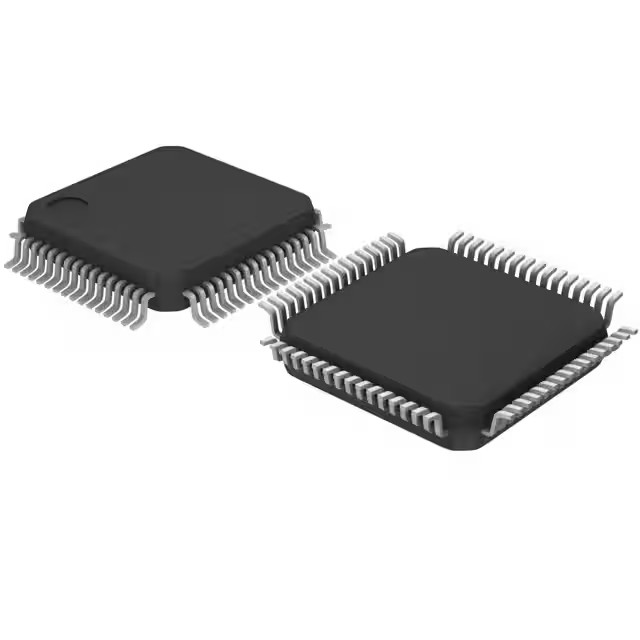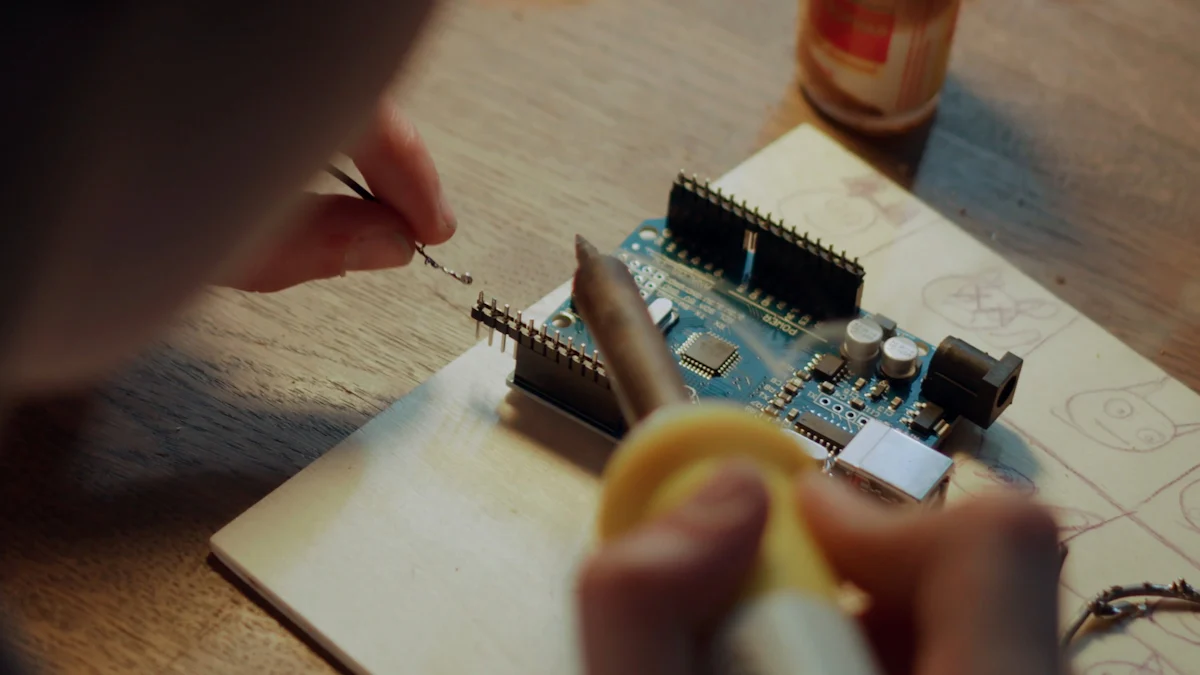Mastering LPC2134FBD64/01 for Consumer and Industrial Automation

The LPC2134FBD64/01 microcontroller plays a vital role in advancing automation across various industries. Its 16/32-bit processing power and integrated features, such as a 10-bit ADC and DAC, make it ideal for industrial control systems, consumer electronics, and IoT devices. This microcontroller excels in applications like motor control systems and human-machine interfaces, offering unmatched versatility and performance.
Key Takeaways
The LPC2134FBD64/01 microcontroller has strong processing power with its ARM7TDMI-S core, making it great for automation tasks.
Its 10-bit ADC and DAC allow accurate signal handling, improving work in home and factory uses.
Developers can connect sensors and devices easily with its flexible I/O features, making automation simpler.
Features and Benefits of the LPC2134FBD64/01 Microcontroller

Key Specifications and Capabilities
The LPC2134FBD64/01 microcontroller offers a robust set of specifications that make it a standout choice for embedded systems. Its ARM7TDMI-S core delivers high processing power, supporting both 16-bit and 32-bit operations. The microcontroller includes 128 kB of flash memory and 16 kB of RAM, ensuring sufficient storage for complex applications. It operates at a maximum clock frequency of 60 MHz, enabling fast and efficient processing.
This microcontroller features a 10-bit ADC and DAC, which provide precise signal conversion for real-time applications. With 47 GPIO pins, it supports extensive interfacing with sensors, actuators, and other peripherals. Its wide operating temperature range (-40°C to +85°C) ensures reliability in industrial environments. The table below summarizes its key specifications:
Specification | Details |
|---|---|
Core | ARM7TDMI-S |
Program Memory Size | 128 kB |
Data RAM Size | 16 kB |
Maximum Clock Frequency | 60 MHz |
ADC/DAC Resolution | 10 bit |
Number of GPIO | 47 I/O |
Interface Type | I2C, SPI, SSP, UART |
Advantages for Automation Projects
The LPC2134FBD64/01 microcontroller excels in automation projects due to its performance and versatility. Its 10-bit ADC and DAC enable advanced signal processing, making it ideal for industrial control systems and IoT devices. The microcontroller supports multiple communication protocols, including SPI, UART, and I2C, ensuring seamless integration with other components.
Its low power consumption and efficient heat dissipation make it suitable for battery-powered devices and compact designs. The LQFP-64 package enhances thermal management, ensuring stable operation in demanding environments. These features make it one of the best microcontrollers for automation, offering a balance of performance and cost-efficiency.
Feature | Description |
|---|---|
Processing Capabilities | 32/64-bit microcontroller |
ADC/DAC | 10-bit ADC and DAC for advanced signal processing |
Flash Storage | 128 kB ISP/IAP flash storage |
Package Type | LQFP-64 for efficient heat dissipation |
Application Fields | IoT devices, embedded systems, automotive control, healthcare monitoring |
Comparison with Other Microcontrollers
The LPC2134FBD64/01 stands out among other microcontrollers due to its processing speed and power efficiency. Its ARM7TDMI-S CPU supports 32-bit code execution at maximum clock rates, ensuring high-speed performance. Unlike many alternatives, it includes fast GPIO ports and dedicated result registers for ADCs, reducing latency and power consumption.
This microcontroller is particularly suitable for real-time applications, offering low latency and high responsiveness. Its versatility makes it a preferred choice for industrial automation and IoT projects. While other microcontrollers may offer similar capabilities, the LPC2134FBD64/01 combines reliability, performance, and cost-effectiveness, making it the best microcontroller for embedded systems.
The LPC2134FBD64/01 supports 32-bit code execution at maximum clock rates, enhancing processing speed.
It includes fast GPIO ports and dedicated result registers for ADCs, improving performance and reducing power consumption.
It is designed for real-time applications, ensuring low latency and high responsiveness.
Applications of the LPC2134FBD64/01 in Automation
Consumer Automation Use Cases
The LPC2134FBD64/01 microcontroller plays a pivotal role in consumer electronics, enabling advanced automation solutions. Its robust processing power and versatile features make it ideal for various applications. The table below highlights some common use cases:
Use Case | Description |
|---|---|
Smart Appliances | Integration in devices like refrigerators and washing machines for automation. |
Home Automation Systems | Control of lighting, heating, and security systems through centralized interfaces. |
Motor Control Systems | Used in applications requiring precise control of motors in various devices. |
This microcontroller’s 16/32-bit RISC processor ensures efficient performance in these applications. Its 10-bit ADC and DAC enable precise signal monitoring and control, while multiple serial interfaces facilitate seamless communication with other devices. These features enhance the functionality and reliability of consumer automation systems.
Industrial Automation Use Cases
The LPC2134FBD64/01 microcontroller is widely used in industrial automation projects due to its reliability and performance. It supports applications such as control panels, motor control systems, and human-machine interfaces. Its 10-bit ADC and DAC provide precise control and monitoring, making it suitable for high-performance embedded systems.
Industrial environments demand durability and efficiency. This microcontroller addresses these needs with its 16/32-bit processing power, up to 512 KB of ISP/IAP flash memory, and advanced power management features. These capabilities ensure stable operation in demanding conditions, making it a preferred choice for industrial automation.
Why It Excels in These Applications
The LPC2134FBD64/01 microcontroller outperforms many alternatives in both consumer and industrial automation scenarios. Its program memory size of 128 kB and data RAM size of 16 kB provide ample storage for complex applications. Operating at a maximum clock frequency of 60 MHz, it delivers superior processing speed compared to models like the LPC2103.
This microcontroller integrates advanced features such as a 10-bit ADC and DAC, multiple serial interfaces, and an interrupt controller supporting up to 255 interrupts. These attributes enable precise control, efficient task management, and seamless communication. Its versatility and cost-effectiveness make it a standout choice for automation projects across various industries.
Implementing the LPC2134FBD64/01 in Automation Projects
Setting Up the Development Environment
Setting up the development environment is the first step in working with the LPC2134FBD64/01 microcontroller. Developers should begin by selecting a reliable Integrated Development Environment (IDE) such as Keil µVision or IAR Embedded Workbench. These tools provide essential features for embedded programming, including code editing, compiling, and debugging. A JTAG debugger or an ISP interface is necessary for flashing the microcontroller and debugging the project.
A stable power supply is critical for reliable operation. The supply voltage must remain within the range of 3.0 V to 3.6 V. Developers should also configure the clock source to achieve the desired speed, up to 60 MHz. Proper thermal management ensures the microcontroller operates efficiently under load. Storing the device in a static-free environment prevents damage during handling.
Programming and Configuring the Microcontroller
Programming the LPC2134FBD64/01 involves configuring its features to meet the project’s requirements. Developers can use the ISP interface to program the flash memory and SRAM for data storage. Configuring I/O pins is essential for interfacing with external components. Built-in pull-up and pull-down resistors simplify this process.
The microcontroller’s ADC and DAC channels should be set up for signal measurement and output. Timers and PWM channels enable precise control in automation tasks. Serial communication interfaces, such as UART, SPI, and I2C, must be initialized with appropriate settings. Enabling the watchdog timer enhances system reliability by preventing unexpected failures.
Integrating Sensors, Actuators, and Peripherals
Integrating sensors, actuators, and peripherals with the LPC2134FBD64/01 microcontroller is straightforward due to its versatile I/O capabilities. Developers can connect sensors for temperature, humidity, or motion detection to the ADC channels. Actuators, such as motors or relays, can be controlled using PWM outputs.
The microcontroller supports multiple communication protocols, allowing seamless integration with external modules like Zigbee or Bluetooth for wireless communication. Developers should ensure proper pin mapping and signal conditioning to avoid errors during operation. Using libraries or APIs simplifies the integration process, reducing development time.
Testing and Debugging for Reliable Performance
Testing and debugging are crucial for ensuring the project’s success. Developers should use a JTAG debugger to identify and resolve issues in the code. Simulating real-world conditions during testing helps validate the microcontroller’s performance.
The watchdog timer should remain active to monitor system health. Developers can use diagnostic tools to analyze signal integrity and communication protocols. Iterative testing ensures the embedded system operates reliably in industrial environments. Proper documentation of test results aids in future maintenance and upgrades.
The LPC2134FBD64/01 microcontroller simplifies automation with its 16/32-bit RISC processor, 10-bit ADC/DAC, and multiple serial interfaces. Its versatility enhances consumer electronics, industrial systems, and medical devices. Developers can leverage NXP’s documentation to start projects. Future trends in automation will benefit from its precise control and real-time processing capabilities. Explore its potential today!
What makes the LPC2134FBD64/01 suitable for real-time applications?
Its ARM7TDMI-S core, 60 MHz clock speed, and low-latency GPIO ports enable fast processing and responsiveness, making it ideal for real-time automation tasks.
Can the LPC2134FBD64/01 support wireless communication?
Yes, it supports wireless communication when paired with modules like Zigbee, Bluetooth, or Wi-Fi. Its versatile interfaces simplify integration with these external modules.
How does the LPC2134FBD64/01 handle power efficiency?
Its low power consumption and advanced power management features ensure efficient operation, making it suitable for battery-powered and energy-sensitive applications.
See Also
Enhancing Process Control with AD74413RBCPZ Insights
Understanding MC9S12DJ256MFUE Specs for Automotive Use
Key Programming Skills for MC9S12XD256 Microcontrollers
Unveiling the Essential Automotive Features of MCF5251CVM140
CALL US DIRECTLY
(+86)755-82724686
RM2508,BlockA,JiaheHuaqiangBuilding,ShenNanMiddleRd,Futian District,Shenzhen,518031,CN
www.keepboomingtech.com sales@keepboomingtech.com
